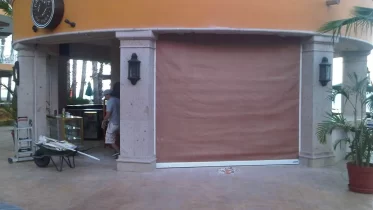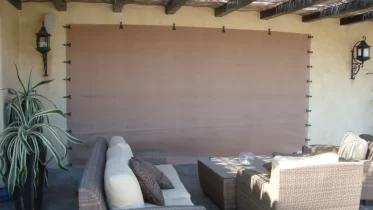
What is Hurricane Fabric?
Hurricane fabric, also known as storm fabric, is a high-strength, lightweight material designed to shield homes from the destructive forces of hurricanes. Made from a blend of synthetic fibers such as Kevlar or polypropylene, this fabric is engineered to withstand high winds and flying debris.
Types of Hurricane Fabric
There are several types of hurricane fabric, including woven, laminated, and hybrid varieties. Woven hurricane fabric, made from tightly interwoven fibers, is known for its durability and flexibility. Laminated fabric includes additional layers for enhanced protection, while hybrid versions combine various materials for superior performance.
History and Development
The concept of hurricane fabric emerged as a response to the need for more practical and user-friendly storm protection solutions. Traditional methods like metal shutters and plywood were effective but cumbersome. Hurricane fabric offers a modern alternative, combining ease of use with high levels of protection.
How Hurricane Fabric Works
Hurricane fabric works by creating a barrier that absorbs and deflects the energy from high winds and flying debris. When properly installed, it can prevent windows and doors from breaking, thereby protecting the home’s interior from damage.
Installation Process
Installing hurricane fabric typically involves attaching the fabric to the exterior of the home using grommets, straps, or clips. The installation can be done by professionals or as a DIY project, depending on the homeowner’s comfort level and the specific system chosen.
Comparison with Traditional Shutters
Compared to traditional shutters, hurricane fabric is much lighter and easier to install. It can be quickly deployed when a storm is approaching and removed and stored compactly when not in use. This convenience, combined with its protective qualities, makes it an attractive option for many homeowners.

Advantages of Hurricane Fabric
Lightweight and Easy to Handle
One of the primary advantages of hurricane fabric is its lightweight nature. Unlike heavy metal shutters, hurricane fabric can be easily handled and installed by most homeowners, making storm preparation less daunting.
Versatility and Adaptability
Hurricane fabric is versatile and can be customized to fit various window shapes and sizes. It can also be used to protect other vulnerable areas of the home, such as doors, patios, and even garage doors.
Cost-effectiveness
In terms of cost, hurricane fabric is often more affordable than traditional storm shutters or impact-resistant windows. Its lower initial cost, combined with the potential for long-term savings on storm damage repairs, makes it a cost-effective choice for many homeowners.
Durability and Strength
Material Resilience
Hurricane fabric is made from highly resilient materials designed to withstand the toughest storm conditions. The synthetic fibers used in its construction are resistant to tearing and UV damage, ensuring long-lasting protection.
Impact Resistance
The fabric is tested to resist impacts from flying debris, a common cause of damage during hurricanes. This impact resistance is critical in protecting the integrity of windows and doors.
Testing Standards
Hurricane fabric is subjected to rigorous testing to meet industry standards for storm protection. These tests ensure that the fabric can withstand the forces it will encounter during a hurricane.
Effectiveness in Storm Protection
Wind Resistance
Hurricane fabric is designed to resist high winds, often up to 150 mph or more, depending on the specific product. This wind resistance helps to prevent windows and doors from breaking under pressure.
Debris Protection
In addition to wind resistance, hurricane fabric provides a barrier against flying debris. By absorbing and deflecting impacts, it helps to prevent penetration and subsequent damage to the home’s interior.
Case Studies and Real-life Examples
Numerous case studies and real-life examples demonstrate the effectiveness of hurricane fabric in storm protection. Homes equipped with this fabric have withstood significant hurricanes with minimal damage, validating its protective capabilities.
Installation Process
Step-by-step Guide
- Measure Windows and Doors: Accurate measurements ensure the fabric fits securely.
- Select Attachment Method: Choose from grommets, straps, or clips based on your preference and the fabric type.
- Install Anchors: Secure the anchors to the home’s exterior.
- Attach Fabric: Fasten the fabric to the anchors, ensuring it is taut and secure.
Professional vs. DIY Installation
While many homeowners opt for professional installation to ensure optimal performance, DIY installation is also feasible for those with basic handyman skills. Instructions provided by manufacturers can guide you through the process.
Tips for Optimal Performance
- Ensure the fabric is taut to prevent flapping in high winds.
- Regularly inspect and maintain attachment points.
- Store the fabric properly when not in use to extend its lifespan.
Cost Analysis
Initial Investment vs. Long-term Savings
Although the initial investment in hurricane fabric may vary, it often proves cost-effective in the long run by reducing potential storm damage and repair costs.
Cost Comparison with Other Protection Methods
When compared to traditional shutters or impact-resistant windows, hurricane fabric is generally more affordable while still offering high levels of protection.
Value Addition to Property
Installing hurricane fabric can increase your property’s value by providing an additional layer of protection that prospective buyers find appealing.
Maintenance and Care
Cleaning and Storage Tips
Clean the fabric with mild soap and water and store it in a cool, dry place when not in use to prevent mildew and deterioration.
Longevity and Replacement Considerations
With proper care, hurricane fabric can last for many years. Inspect it regularly for signs of wear and replace it if it shows significant damage.
Common Issues and Solutions
Common issues include fabric tears or damaged attachment points. Most of these can be repaired with kits provided by manufacturers or by a professional.
Comparing Hurricane Fabric to Other Storm Protection Solutions
Traditional Shutters
While traditional shutters offer robust protection, they are often heavier and more challenging to install. Hurricane fabric provides similar protection without the bulk.
Impact-resistant Windows
Impact-resistant windows offer continuous protection but at a higher cost. Hurricane fabric can be a more economical alternative that can be removed and stored when not needed.
Temporary Barriers like Plywood
Plywood is a common temporary solution but lacks the durability and ease of use of hurricane fabric. It is also less aesthetically pleasing and can be cumbersome to install.
Environmental Impact
Eco-friendly Materials
Many hurricane fabrics are made from recyclable materials, making them an environmentally friendly choice.
Sustainability Benefits
By reducing the need for frequent replacements and repairs, hurricane fabric contributes to sustainability efforts.
Role in Green Building Certifications
Using eco-friendly storm protection solutions like hurricane fabric can contribute to achieving green building certifications, adding to the environmental value of your home.

Customizing Hurricane Fabric
Size and Fit Options
Hurricane fabric can be customized to fit any window or door size, ensuring comprehensive protection.
Additional Features and Upgrades
Options like UV protection, fire resistance, and aesthetic enhancements can be added to hurricane fabric to increase its functionality and appeal.
Aesthetic Considerations
Unlike bulky shutters, hurricane fabric is unobtrusive and can blend seamlessly with your home’s exterior, maintaining its visual appeal.
User Testimonials and Feedback
Homeowner Experiences
Many homeowners report high satisfaction with hurricane fabric, noting its ease of use and effective protection during storms.
Professional Reviews
Experts in storm protection often recommend hurricane fabric for its combination of strength, flexibility, and cost-effectiveness.
Examples from Hurricane-prone Areas
In regions frequently hit by hurricanes, hurricane fabric has proven its worth by protecting homes from significant damage, reinforcing its credibility as a reliable storm protection solution.
Challenges and Limitations
Potential Downsides
While effective, hurricane fabric may not be suitable for all homes, particularly those with irregularly shaped windows or doors.
Situations Where it May Not Be Ideal
Homes in extremely high-wind areas might require additional reinforcement beyond what hurricane fabric alone can provide.
Mitigating Limitations
Combining hurricane fabric with other protection methods, such as impact-resistant windows, can offer comprehensive storm protection.

Future Trends in Hurricane Fabric Technology
Innovations in Materials
Ongoing research into stronger and more resilient materials promises to enhance the effectiveness of hurricane fabric.
Technological Advancements
Integration with smart home systems for automated deployment is a future trend that could increase the convenience and effectiveness of hurricane fabric.
The Future Outlook for Hurricane Fabric
As technology advances, hurricane fabric will likely become even more effective and user-friendly, solidifying its place as a leading storm protection solution.
Conclusion
Hurricane fabric is a highly effective and versatile solution for storm protection. Its lightweight nature, ease of installation, and cost-effectiveness make it a popular choice among homeowners in hurricane-prone areas. With ongoing advancements in materials and technology, hurricane fabric continues to improve, offering reliable protection against the destructive forces of hurricanes.
FAQs
Is hurricane fabric suitable for all types of homes?
Yes, hurricane fabric can be customized to fit various window and door sizes, making it suitable for most homes.
Can hurricane fabric be used in combination with other protection methods?
Absolutely. It can complement other methods like impact-resistant windows for enhanced protection.
How long does hurricane fabric last?
With proper care and maintenance, hurricane fabric can last for many years, providing long-term storm protection.
Is professional installation necessary?
While professional installation ensures optimal performance, many homeowners successfully install hurricane fabric themselves with the help of manufacturer instructions.
What are the warranty options for hurricane fabric?
Most manufacturers offer warranties that cover defects in materials and workmanship, providing peace of mind for homeowners.